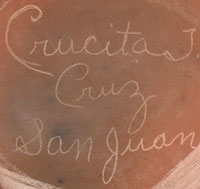San Juan Pueblo Polychrome Pottery Dish from the 1930s by Crucita Trujillo Cruz [SOLD]
+ Add to my watchlist Forward to Friend
- Category: Modern
- Origin: Ohkay Owingeh, San Juan Pueblo
- Medium: clay, pigment
- Size: 10” diameter x 1-¼” deep
- Item # C4382B SOLD
This polychrome pottery dish by artist Crucita Trujillo Cruz beautifully expresses the new style pottery developed at San Juan Pueblo in the 1930s to replace the traditional undecorated style that had existed for hundreds of years. The design is awe-inspiring with geometric shapes—triangles, curves, straight lines, rectangles, and circles. The central element is a beige triangle that is the color of tanned leather. The three legs of the triangle are outlined with small cream-color dots. Surrounding the triangle are three semicircular designs that feature clouds in beige color and stepped clouds in dark red color. Each of the curved clouds has rain in triangular form falling on rectangular fields. Three floral designs, in yellow, hug the edge of the design. A half-inch wide beige band frames the designs. The edge of the dish and the underside are stone-polished red slip— a tie to the past style of polished red clay.
San Juan Pueblo, now known as Ohkay Owingeh Pueblo, is a village of Tewa-speaking people who are descendants of Po’pay (or Popé) and his allies who led the Pueblo Revolt of 1680. Their traditional pottery style was Red-over-tan, devoid of decoration, and embellished with fire clouds. This changed as a result of excavations around 1930 at their ancestral pueblo Potsuwi’i where ancient pottery (c.1450-1500) with incised designs were unearthed. Further research at the Museum of New Mexico with Kenneth Chapman by several potters resulted in a change in San Juan pottery to incorporate their prehistoric style.
 Crucita Trujillo Cruz (1886-1969) was one of the original seven potters at the pueblo who investigated the historic wares and settled on a new style for a San Juan pottery revival. [Schaaf, 2000:241] There is a similarity in appearance with this painted style to that of their neighboring Tewa-speaking Santa Clara Pueblo. Crucita Trujillo Cruz was also known as Phe Povi (Flower Stick).
Crucita Trujillo Cruz (1886-1969) was one of the original seven potters at the pueblo who investigated the historic wares and settled on a new style for a San Juan pottery revival. [Schaaf, 2000:241] There is a similarity in appearance with this painted style to that of their neighboring Tewa-speaking Santa Clara Pueblo. Crucita Trujillo Cruz was also known as Phe Povi (Flower Stick).
It appears that pottery by Crucita Cruz is rare, as Schaaf, in his referenced book below, only indicates a single jar in the Laboratory of Anthropology collection and a single one in the School of American Research collection, both of which are micaceous jars, not painted ones. A review of Adobe Gallery sales does not indicate that we have ever had one of her works in the past. The dish is signed with the name of the potter.
Condition: some scratches at the rim, most likely from a plate hanger, and some minor spotting on the design which is not intrusive.
Provenance: this San Juan Pueblo Polychrome Pottery Dish from the 1930s by Crucita Trujillo Cruz is from the collection of a resident of Santa Fe
Reference: Schaaf, Gregory. Pueblo Indian Pottery 750 Artist Biographies
Relative Links: Southwest Indian Pottery, Ohkay Owingeh, San Juan Pueblo, Crucita Trujillo Cruz (1886-1969) Phe Povi, Flower Stick
- Category: Modern
- Origin: Ohkay Owingeh, San Juan Pueblo
- Medium: clay, pigment
- Size: 10” diameter x 1-¼” deep
- Item # C4382B SOLD



